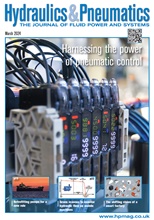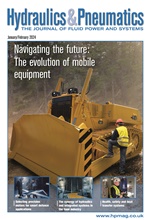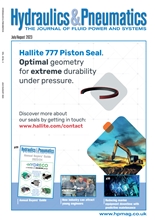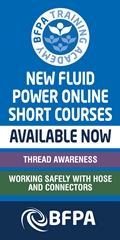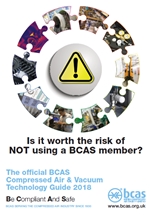Selecting the best lubricants for offshore equipment
By Phil Cumberlidge, business development manager, Greenmarine, Panolin International Inc.
Petroleum based (mineral) oils have been around for over 100 years and the performance and limitations of them are well-known. Now, with the advent of environmental requirements for (non-engine) lubricants for the prevention of pollution from vessels and offshore installations, the selection process for lubricants can be more confusing than ever.
The base oils of lubricants that are generally accepted as being environmentally ‘friendly’ - or ‘Environmentally Acceptable Lubricants’ (EALs) are:
• Triglycerides, commonly known as vegetable oils.
• Polyalkylene glycols, shortened to Polyglycols.
• Polyalphaolefins, or synthetic ‘hydrocarbons’ (man-made mineral oil).
• Synthetic Esters – two classes: fully Saturated Esters and Unsaturated Esters.
So, how does one decide which base oil type to select? – and then, which supplier of that base oil type lubricant does one choose, if there are more than one supplier?
First, if we take the environmental properties of the different EALs, as a ‘given’ and out of the equation, this simplifies the decision making process. Whilst there are different lengths of time for biodegradation of these lubricants to take place (minimum limit is 60 per cent biodegrading in 28 days, but some are more ‘friendly’ and degrade more than 70 per cent in that time) and some EALs are heavier than fresh water and seawater and therefore sink, out of view – not so friendly.
Look for accreditations such as Euromargerite (Ecolabel) and CEFAS (the Centre for Environment, Fisheries and Aquaculture Science for the UK). The Offshore Chemical Notification Scheme (OCNS - Group E) manages chemical use and discharge by the UK and Netherlands offshore petroleum industries. The scheme is regulated in the UK by the Department of Energy and Climate Change using scientific and environmental advice from CEFAS and Marine Scotland.
Those accredited lubricants will be in compliance with the OSPAR Convention (the Convention for the Protection of the marine environment of the north-east Atlantic), with particular reference to Annex III: Prevention and elimination of pollution from offshore sources and the Harmonised Offshore Chemical Notification Format (HOCNF), which applies to all chemicals used in connection with offshore exploration and production activities in the OSPAR maritime area. Ensure that there are no ‘substitution warnings’ for the replacement of harmful chemicals within the lubricant.
Secondly (this is the hard one to pass), it is the performance of the lubricant. What do you need to look for in the lubricant(s) you are choosing? If we use the analogy of Formula 1 Racing, the success of the car is primarily derived through the chassis, the engine/gearbox and through-race reliability; not to forget, driver input.
The base oil is the chassis, with inherent stability. Properties of the chassis of the oil include: viscosity stability (generally the most important property of the oil); anti-ageing; low temperature flow; corrosion protection; compatibility with materials in contact with the oil and effect of any water ingress (hydrolysis and demulsibility). The engine/gearbox is the designed/engineered performance of the oil - the selection of additives to complement the base oil: to enhance viscosity, or to further depress pour point for operation at lower temperatures; to provide shear stability; anti-wear/extreme-pressure additives and friction modifiers.
Reliability and long-life comes from the combined optimum high performance of the ‘chassis’ and the ‘engine/gearbox’ and is the sum of:
• The stability of the base oil viscosity and shear – with no need for viscosity improvers that can be broken-down
• Its resistance to ageing - oxidation and thermal stress – not depositing varnish, or gumming
• The stability of the dispersion of the additives and not separating, or being filtered-out
• The compatibility with seals, metals and protective coatings, to not cause component degradation, failure or corrosion
• The stability with contaminants – other oils and water – to not cause emulsions that cannot readily separate the water, that can lead to bacterial growth, bad smells and corrosion
The third and easiest decision is the cost of acquiring your lubricants. If your selection is based on lowest price, then there is the choice of the lower cost (lower performance) base oil ‘blends’. However, if you are looking at the ‘long-term game plan’, then this is where the through-life reliability of your oil gives you beneficial pay-back.
Marine and Offshore systems’ OEMs, operators and construction companies have been gathering information over the past few years about the performance issues surrounding the use of EALs. Issues such as the following have become evident with some types of EALs:
• Increasing oil viscosity – due to poor thermal stability.
• Decreasing oil viscosity – due to shear instability.
• Slime and bad smells – due to water contamination and oxidation.
• Varnish and gumming of the system – due to thermal degradation.
• Corrosion of equipment internals – due to the hygroscopic nature of the lubricant.
• Overheating of propulsion systems – questioning oil film thickness and frictional characteristics.
• Difficult filterability.
• Difficult change-over from mineral oils.
Currently, fully saturated synthetic esters are in ‘pole position’, leading the way in high performance and long-life marine lubricants; with the added benefit of being environmentally considerate and reducing your carbon footprint coming ‘free of charge’ (almost – OK, the minimally toxic performance additives come at a higher price than those used in toxic mineral oils).
It is the lubricant manufacturer’s job to tell you all about the key performance indicators of their lubricant(s) – consult them.
-
Smart Manufacturing & Engineering Week
05 - 06 June, 2024
NEC, Birmingham -
HILLHEAD 2024
25 June, 2024, 9:00 - 27 June, 2024, 16:00
Hillhead Quarry, Buxton, Derbyshire UK



